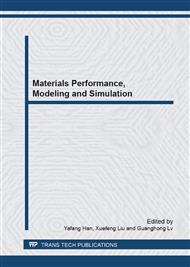[1]
Tang J J, Geng M P, Rao L, Zhang Y, et al. Influence of Technology Parameters on Casting's Quality under Electro-slag Remelting Casting Process. Hot Working Technology 2010, Vol. 39: 45.
Google Scholar
[2]
Patel A D. Gerbeth G ed. Proceedings of the 6th International Conference 011 Electromagnetic Processing of Materials. Dresden: For chungs zen trum Dresden—Rossend off, 2009: 603.
Google Scholar
[3]
Dong y w, Jiang Z H, Zhao H M, Zhang X F, et al. Numerical Simulation of Producing Large ESR Ingots. Journal of Materials and Metallurgy, Vol. 10, March 2011: 110.
Google Scholar
[4]
Gandin C A, Rappaz M. A 3D Cellular Automaton Algorithm for the Prediction of Dendritic grain growth. Acta Metal Mater, 1997, 45(5): 2187.
DOI: 10.1016/s1359-6454(96)00303-5
Google Scholar
[5]
Sang B G, Zhang X W, Kang X H, et al. Solidification Simulation and Experimental Investigation of Heavy Steel Ingot. Foundry Mar, 2010, 59 (3): 278.
Google Scholar
[6]
Wang T M. Research on the Micro-modeling of Metal Solidification Process [Dissertation]. Dalian:Dalian University of Technology, (2000).
Google Scholar
[7]
Wang J L Wang F M, Li C R, et al. Simulation of Solidification Processes of 9SMn28 Free-cutting Steel Based on a CAFE Method. Journal of University of Science and Technology Beijing, 2010, 32 (3) : 325.
DOI: 10.1002/srin.200900109
Google Scholar
[8]
Liu D R. Numerical Simulation of Solidification Structure Formation of TiAl Alloy Ingots [Dissertation]. Harbin: Harbin Institute of Technology, 2005,: 58.
Google Scholar
[9]
Zenon I, Mieczyslaw H, Jakub H. Prediction of Dendritic Microstructure Using the Cellular Automaton Finite Element Method for Hypoeutectic Al-Si Alloys Castings. Mater Sci, 2006, 12 (2): 124.
Google Scholar
[10]
Gandin Ch-A, Desbiolles J-L, Rappaz M, et al. A Three-dimensional Cellular Automaton Finite Element Model for the Prediction of Solidification Grain Structures. Metallurgical and Materials Transactions A, 1999, 30(12): 3153.
DOI: 10.1007/s11661-999-0226-2
Google Scholar
[11]
Kampfer T U. Modeling of Micro-segregation using an Adaptive Domain Decom Position Method [Dissertation]. Lausanne: Ecole Poly technique Fédérale de Lausanne, 2002: 31.
Google Scholar
[12]
Ouchi C, Sampei T, Kozasu I, et al. The Effect of Hot Rolling Condition and Chemical Composition on the Onset temperature of γ-α transformation after Hot Rolling. Transactions, ISJJ Int, 1982, 26 (22): 215.
DOI: 10.2355/isijinternational1966.22.214
Google Scholar
[13]
Yu J Q, Yi W Z, Chen B D, et al. Binary Alloy Phase Diagram. Shanghai: Shanghai Scientific and Technical Publishers, 1987: 366.
Google Scholar
[14]
Chen J X. Ferrous Metallurgy. Beijing: Metallurgical Industry Press, 2004: 311.
Google Scholar
[15]
Li W C. Physical Chemistry of Metallurgy and Material. Beijing: Metallurgical Industry Press, 2001: 531.
Google Scholar


